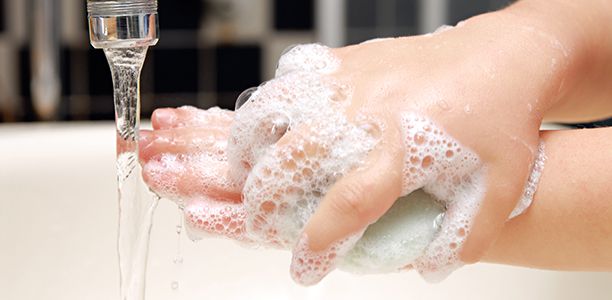Washing hands is one of the best ways to prevent the spread of diseases. While your child might come and tell you they’ve washed their hands after simply splashing them in water, a quick splash is not enough to remove the germs that cause disease. To keep their hands hygienically clean, children need to use soap and they need to use it properly.
While children seem to be born with an instinct to stick their hands in just about any sticky, gooey, dirty substance they can find, unfortunately they are not born with a natural instinct to wash their hands properly with soap and water. They need to learn how to keep their hands clean and parents need to do what they can to ensure their children develop good hand hygiene practices as early as possible.
How to teach children to wash their hands
It’s important for parents not to assume that their children know how to wash their hands correctly. You’ll need to teach them and until they are old enough to do it themselves, you’ll need to supervise them and help them to ensure they wash their hands well enough to remove germs. Because the germs which need to be cleaned off hands are too small to be seen, you’ll need to teach your child why they need to clean their hands, even if they appear clean.
As kids tend to find playing with toys or running around more enjoyable than hand washing, don’t be surprised if learning how to wash hands involves a bit of whinging and perhaps the odd temper tantrum. But rest assured with persistence and a bit of creativity, your child will develop the skills to wash their hands independently before you know it.
There are many fun strategies like songs and games that parents can use to teach their children how to wash their hands properly. Firstly you need to know how to wash your own hands correctly, so that you can be a hand washing role model for your child.
When should children be able to wash their own hands?
Children generally know how to wash their own hands by age four and most five year old will also have developed the knowledge of when they should wash their hands (e.g. after going to the toilet). Young children and toddlers will not only need to be reminded to wash their hands, they’ll also need a helping hand to do it. And if you’re caring for a baby, you’ve almost certainly worked out by now that you’ll have to clean their hands for them.
Correct technique for washing with soap and water
The correct technique for washing hands is the same for adults and children. It takes about 60 seconds to wash and dry your hands using this technique. Your child should be able to sing ‘Happy Birthday’ twice in the time it takes them to wash their hands.
When teaching a child to wash their hands, be sure to explain each step to them clearly and simply. Help them out by demonstrating or helping them perform hand washing actions like rubbing hands together to lather the soap. Focus on what they do correctly, rather than the bits they don’t get right. And don’t forget to praise every step and congratulate them when they’ve finished washing their hands.
Before you start washing
Before you begin washing your hands or your child’s hands:
- Remove any jewellery, with the exception of plain rings. Jewellery covers the skin on the hands and makes it harder to wash your hands. If you wear a wrist watch it should also be removed before you start washing your hands.
- Cover any cuts on your hands with a waterproof dressing.
To wash your hand properly
To wash your hands properly with soap and water:
- Wet your hands thoroughly with water. It doesn’t matter if you use hot or cold water- both are equally effective.
- Apply enough soap to remove the germs from your hands:
- If you’re using a bar of soap, rub it in your hands until you have created enough lather to cover the front and back of both hands.
- If you use a liquid soap, apply a dollop to your palm and rub your hands until you have created a lather which completely covers both hands.
- Pull your hands out of the running water while you lather the soap to ensure you don’t wash it away before it has had time to clean away the germs on your hands. Lather the back and front of the hands, the wrists and the fingernails, ensuring not to miss any spots. Pay special attention to your finger tips and the spaces between your fingers, thumbs and wrists, as people often miss these spots when washing their hands.
- Lather your hands with the soap for 15-20 second;
- Rinse hands thoroughly under running water. Do not use a bowl or sink full of water for rinsing. Keep your hands with your fingers pointing down to ensure that the contaminated rinse water drains down the sink and does not run down your wrists and elbows;
- If the tap needs to be turned off manually, cover your hand with a disposable paper towel to turn off the tap. This helps stops germs that have contaminated the tap getting onto your hands.
Drying your hands after washing
It is also important to thoroughly dry your hands each time you wash them, as wet hands are more likely to pick up germs. The best way to dry your hands is to:
- Use a disposable paper towel;
- Pat your hands against the towel rather than rubbing them. Rubbing the hands can cause skin damage;
- Do not use a multiple use towel as the towel may harbor germs which can re-contaminate your hands;
- If you are washing your hands in a public toilet, using an hot air dryer is an effective way to dry your hands.
- You may also wish to apply moisturizing lotion to your hands after washing to prevent chaffing. (Using mild soap and warm water and patting rather than rubbing hands dry can also help to prevent chaffing).
Other things you can do to make hand washing easy
There are also some additional things you can do to make it easier for your child to wash their hands properly.
- Keep your child’s finger nails short and clean, so that germs and dirt do not build up under the mails and make them harder to clean.
More information about handwashing techniques and activities for kids.
References
- South Australian Health Infection Prevention and Control. Hand Hygiene Guideline. 2010. (cited 19 January 2014). Available from: (URL Link)
- Vanderbilt University. Teaching your child to become independent with daily routines. 2010. (cited 19 January 2014). Available from: (URL Link)
- Utah Department of Health. Hand Washing Information. 2005. (cited 19 January 2014). Available from: (URL Link)
- National Health and Medical Research Council. Hand washing. In Preventing Infectious Diseases in Childcare. 4th Ed. 2006. (cited 19 January 2014). Available from: (URL Link)
- World Health Organization. WHO guidelines on hand hygiene in healthcare: (Advanced Draft – Clean Hands are Safer Hands. 2005. (cited 19 January 2014). Available from: (URL Link)




 (3 votes, average: 3.67 out of 5)
(3 votes, average: 3.67 out of 5) 







